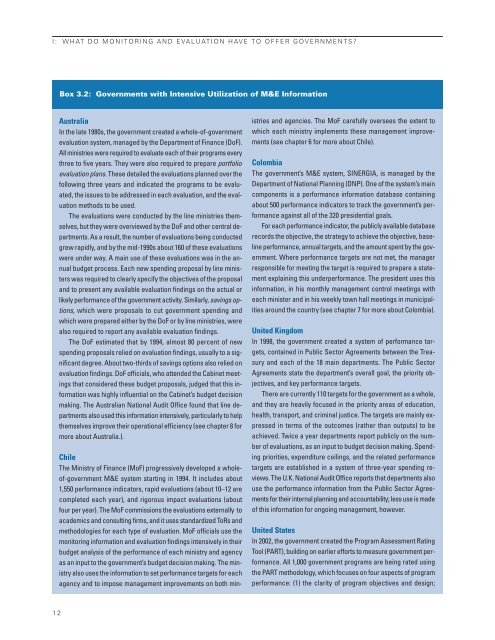How to Build M&E Systems to Support Better Government How to ...
How to Build M&E Systems to Support Better Government How to ...
How to Build M&E Systems to Support Better Government How to ...
You also want an ePaper? Increase the reach of your titles
YUMPU automatically turns print PDFs into web optimized ePapers that Google loves.
I: WHAT DO MONITORING AND EVALUATION HAVE TO OFFER GOVERNMENTS<br />
Box 3.2: <strong>Government</strong>s with Intensive Utilization of M&E Information<br />
Australia<br />
In the late 1980s, the government created a whole-of-government<br />
evaluation system, managed by the Department of Finance (DoF).<br />
All ministries were required <strong>to</strong> evaluate each of their programs every<br />
three <strong>to</strong> five years. They were also required <strong>to</strong> prepare portfolio<br />
evaluation plans. These detailed the evaluations planned over the<br />
following three years and indicated the programs <strong>to</strong> be evaluated,<br />
the issues <strong>to</strong> be addressed in each evaluation, and the evaluation<br />
methods <strong>to</strong> be used.<br />
The evaluations were conducted by the line ministries themselves,<br />
but they were overviewed by the DoF and other central departments.<br />
As a result, the number of evaluations being conducted<br />
grew rapidly, and by the mid-1990s about 160 of these evaluations<br />
were under way. A main use of these evaluations was in the annual<br />
budget process. Each new spending proposal by line ministers<br />
was required <strong>to</strong> clearly specify the objectives of the proposal<br />
and <strong>to</strong> present any available evaluation findings on the actual or<br />
likely performance of the government activity. Similarly, savings options,<br />
which were proposals <strong>to</strong> cut government spending and<br />
which were prepared either by the DoF or by line ministries, were<br />
also required <strong>to</strong> report any available evaluation findings.<br />
The DoF estimated that by 1994, almost 80 percent of new<br />
spending proposals relied on evaluation findings, usually <strong>to</strong> a significant<br />
degree. About two-thirds of savings options also relied on<br />
evaluation findings. DoF officials, who attended the Cabinet meetings<br />
that considered these budget proposals, judged that this information<br />
was highly influential on the Cabinet’s budget decision<br />
making. The Australian National Audit Office found that line departments<br />
also used this information intensively, particularly <strong>to</strong> help<br />
themselves improve their operational efficiency (see chapter 8 for<br />
more about Australia.).<br />
Chile<br />
The Ministry of Finance (MoF) progressively developed a wholeof-government<br />
M&E system starting in 1994. It includes about<br />
1,550 performance indica<strong>to</strong>rs, rapid evaluations (about 10–12 are<br />
completed each year), and rigorous impact evaluations (about<br />
four per year). The MoF commissions the evaluations externally <strong>to</strong><br />
academics and consulting firms, and it uses standardized ToRs and<br />
methodologies for each type of evaluation. MoF officials use the<br />
moni<strong>to</strong>ring information and evaluation findings intensively in their<br />
budget analysis of the performance of each ministry and agency<br />
as an input <strong>to</strong> the government’s budget decision making. The ministry<br />
also uses the information <strong>to</strong> set performance targets for each<br />
agency and <strong>to</strong> impose management improvements on both ministries<br />
and agencies. The MoF carefully oversees the extent <strong>to</strong><br />
which each ministry implements these management improvements<br />
(see chapter 6 for more about Chile).<br />
Colombia<br />
The government’s M&E system, SINERGIA, is managed by the<br />
Department of National Planning (DNP). One of the system’s main<br />
components is a performance information database containing<br />
about 500 performance indica<strong>to</strong>rs <strong>to</strong> track the government’s performance<br />
against all of the 320 presidential goals.<br />
For each performance indica<strong>to</strong>r, the publicly available database<br />
records the objective, the strategy <strong>to</strong> achieve the objective, baseline<br />
performance, annual targets, and the amount spent by the government.<br />
Where performance targets are not met, the manager<br />
responsible for meeting the target is required <strong>to</strong> prepare a statement<br />
explaining this underperformance. The president uses this<br />
information, in his monthly management control meetings with<br />
each minister and in his weekly <strong>to</strong>wn hall meetings in municipalities<br />
around the country (see chapter 7 for more about Colombia).<br />
United Kingdom<br />
In 1998, the government created a system of performance targets,<br />
contained in Public Sec<strong>to</strong>r Agreements between the Treasury<br />
and each of the 18 main departments. The Public Sec<strong>to</strong>r<br />
Agreements state the department’s overall goal, the priority objectives,<br />
and key performance targets.<br />
There are currently 110 targets for the government as a whole,<br />
and they are heavily focused in the priority areas of education,<br />
health, transport, and criminal justice. The targets are mainly expressed<br />
in terms of the outcomes (rather than outputs) <strong>to</strong> be<br />
achieved. Twice a year departments report publicly on the number<br />
of evaluations, as an input <strong>to</strong> budget decision making. Spending<br />
priorities, expenditure ceilings, and the related performance<br />
targets are established in a system of three-year spending reviews.<br />
The U.K. National Audit Office reports that departments also<br />
use the performance information from the Public Sec<strong>to</strong>r Agreements<br />
for their internal planning and accountability; less use is made<br />
of this information for ongoing management, however.<br />
United States<br />
In 2002, the government created the Program Assessment Rating<br />
Tool (PART), building on earlier efforts <strong>to</strong> measure government performance.<br />
All 1,000 government programs are being rated using<br />
the PART methodology, which focuses on four aspects of program<br />
performance: (1) the clarity of program objectives and design;<br />
12
















![[PDF] Community Development Toolkit - CommDev](https://img.yumpu.com/48616495/1/184x260/pdf-community-development-toolkit-commdev.jpg?quality=85)
